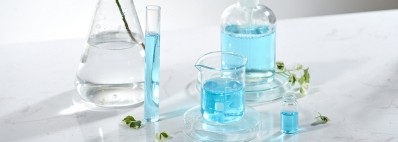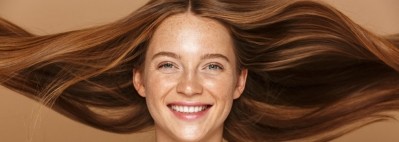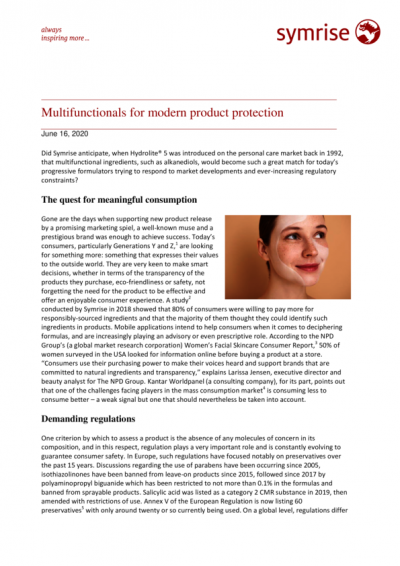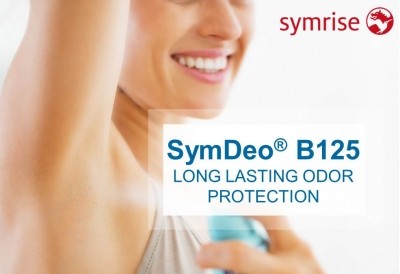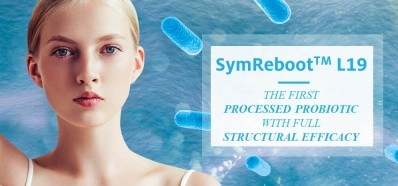Promotional Features
Challenging the status quo of microbiome research with a holistic perspective on human ecosystems
Perceptions and attitudes have changed. Traditionally, we aimed at eradicating all bacteria, fungi, and viruses that we perceived as threats to our health and wellbeing. At Symrise, we are passionately welcoming beneficial microorganisms into our lives.
The human microbiome is a very complex system affecting many areas of the body. Microorganisms live inside of our mouth and the digestive system and live on the surface of our bodies, on the skin, the scalp, and in the underarm area. Each niche in and on our bodies is unique, each microbiome is different. For example, the gut harbors around 10x109 bacteria while the scalp is home to around 10x106 bacteria per cm². Microbial species diversity is different in each of those niches and we roughly count 10,000 species of microorganisms in and on the body.
All this diversity makes up the flourishing ecosystems of the human body, providing different ecological niches and nutrients for the microorganisms in and on our bodies. An imbalance in these ecological niches or nutrients can lead to overgrowth of specific bacteria which could lead to an unhealthy microbiome and eventually cause disease. Additionally, we have to take into consideration any external factors that influence the body. Factors are an individual’s diet, geographic location, lifestyle, age, and genetic predisposition which will lead to a unique microbiome composition. A person’s microbiome is as unique as their fingerprint.
In fact, we can compare the microbiome to a complex ecosystem influenced by many single biological and non-biological factors. A change in the microbiome could result in ecosystem imbalances but likewise, ecosystem imbalances could affect the composition and health of the microbiome. Only with a truly balanced ecosystem, a person looks and feels like their healthy self.
Now, how does one maintain a healthy microbiome considering all these internal and external factors?
At the forefront of microbiome research, Symrise developed SymProBiome, a microbiome platform dedicated to connecting science and innovation to decode and understand the microbiome and revolutionize product development.
SymProBiome research is built on the understanding that the human body and the different microbiomes mutually influence each other. To visualize the inter-connectedness of the microbiomes and the human body, we make the comparison between planet earth and its own ecosystems.
In that context, we can compare between a desert and dry skin; a lush forest and the sweat and moist skin; rich soil of daisy flowers and the scalp; a reef ecosystem and the oral cavity; but also, the oxygen of the air and essential preservation and product protection enhancement.
The skin is a visible indicator of a person’s health and beauty status. Red, dry skin and also lesions or acne reflect an impacted skin microbiome. As skin acts as the first line of defense against pathogens and external changes, we must pay special attention to its microbiome.
Therefore, the beauty industry is focusing more and more on microbiome friendly ingredients in skincare product development. The interest in the microbiome began with dietary supplements inspired by many studies on the gut microbiome and beneficial resident microorganisms. Today, this interest has also transitioned into cosmetics and we can discover a variety of skincare products based on pre-, pro- and post-biotics.
For different body regions, there are significant variations in total number of bacteria and species diversity, with or without sweat glands, and with or without sebaceous glands. The microbiome diversity reflects differences in the amount of moisture and nutrients on these body sites. For this reason, SymProBiome differentiates three main ecological environments of the skin: the dry, sweat and moist skin, and the scalp.
Dry skin microbiome - the desert ecosystem
Similar to the desert, skin can also appear as an environment with very limited moisture. For example, these areas are the hands, the forearms, and shins. These areas lack sweat or sebaceous glands as part of the dermis. However, the epidermis is rich in bacteria and fungi which represent the dry skin microbiome such as Cornyebacterium, Cutibacterium, Malassezia and Staphylococcus.
Combining the comprehensive knowledge of the microbiome and skin care with Probi’s probiotics expertise, Symrise developed SymReboot L19 - Lactobacillus plantarum HEAL19 - a microbiome friendly ingredient. It leaves the residual natural microbiome of healthy skin intact. It visibly reduces extra dry skin condition and strengthens the skin’s defense mechanisms.
By supporting the skin’s health and instinctive defenses, SymProBiome takes special care of the dry skin ecosystem, which will result in a healthy skin appearance and natural beauty.
Sweat and moist skin microbiome - the lush forest ecosystem
While the dry skin is a desert, we can compare the underarm to a lush forest with more than 1 million bacteria per cm² skin. Various microenvironments shape the sweat microbiome, such as hair follicles, bare skin, sebaceous glands and different sweat glands, such as eccrine and apocrine sweat glands.
In stressful situations, hormones will trigger the production of apocrine glands responsible for malodor when releasing fatty acids and amino acids derivatives. They deliver the right nutrients for odor-causing bacteria to thrive.
SymProBiome research focuses on developing safe ingredients that work in harmony with the microbiome and reliably inhibit odor.
SymDeo B125 works well as a deodorant active (as known from in vivo studies) while exerting little impact on the total underarm microbiome.
In addition to delivering fast and mild freshness, Frescolat ML decreases sweat odor by acting on the axillary microbiome and supporting deodorant activity.
Scalp microbiome - the rich soil of daisy flowers
Sebaceous areas of the human scalp provide an oily and hairy environment for the microbiome supporting the presence of specific bacteria such as Cutibacterium and Staphylococcus but also the fungal genus Malassezia. Excess growth of Malassezia species can lead to dandruff formation.
SymProBiome creates innovative dandruff control solutions by better understanding bacteria, fungi, and scalp interactions.
Crinipan PMC green, the innovative micro-activated naturally derived anti-dandruff ingredient, supports a favorable shift of the balance of Staphylococcus/Propionibacterium to ensure a healthy scalp microbiome. It visibly eliminates flakes on the scalp after 30 days of use.
The microbiotic solution for sensitive and dry scalp, SymReboot L19 restores the scalp’s own natural defenses for a sustainably strengthened barrier. It improves dry scalp condition by reducing dry flakes after only two weeks of treatment with shampoo and by soothing scalp discomfort (redness and itching).
Product protection - the O2 of microbiome beauty
Formulation of microbiome-friendly cosmetic products can present a real challenge for formulators who create products that keep the natural skin flora intact and healthy but also ensure a formula can resist spoilage on the shelf and in consumer hands.
SymProBiome develops multifunctional ingredients with a multitude of benefits such as moisturization and antioxidant capabilities but also the need for product protection enhancement. Symrise’s multifunctionals, Hydrolite 5 green, Hydrolite CG, and Hydrolite 7 green, and SymSave H, at effective concentrations for product protection, maintained the microbiome of healthy skin.
Oral cavity - the reef ecosystem
Oral cavity hosts the second most diverse microbial community within the body with 1,000,000,000 to 6,000,000,000 bacteria per cm² and 775 microbial species – as the diversity of species living in the reef.
With the aim to support a positive change of the microbiome by influencing the increase of the health-associated bacteria proportion and vice versa, SymProBiome uses natural and diverse oral biofilms in an ex vivo model to screen potential oral care ingredients for efficacy.
Optafresh D selectively fights bacteria responsible for bad breath while working well with a pleasant mint oral care formula.
SymGuard CD targets the oral microbiome and is especially effective against Streptococcus mutans biofilm which can be responsible for caries and periodontal infections.
SymReboot OC increases the relative proportion of oral health-associated species and reduces harmful species, supporting periodontal health in order to promote a healthy oral microbiome.
Gut – the tropical rainforest ecosystem
The human gastrointestinal tract harbors the highest density of microorganisms in the body (30.000 to 50.000 billion of microorganisms, representing 3 to 10 times more than the number of cells in our body). Our gut microbiota is playing a critical role in our health through some key functions: defense, nutrition.
Diversity is key from both diet and gut microbiota perspective and a diet rich in dietary fiber, polyphenols, vitamins, minerals as well as fermented food is the best to ensure proper functioning of our gut bacteria.
SymProBiome develops science-based innovative natural functional solutions to keep the gut microbiota in good shape and promote good health using the latest technologies (e.g. metagenomics, metabolomics) and collaborating with leading worldwide scientific experts.
Sources:
E.A.Grice and J.A.Segre; Nature Reviews; Microbiology Vol.9, April 2011, p.245
The Human Microbiome Project Consortium (2012) in Nature 486 (7402), 207-214 and 215-221
Sender R, Fuchs S, Milo R. Revised Estimates for the Number of Human and Bacteria Cells in the Body. PLoS Biol. 2016 Aug 19;14(8):e1002533.
Barnard & Li (2017) J Physiol 595.2 pp 437-450
Disclaimer: The information provided herein is for informational purposes only. Symrise does not endorse and makes no representation that this cosmetic raw material is a drug active or biocidal ingredient. Companies should consult with legal counsel for any claims that they wish to make on their finished product, as it is their responsibility to ensure compliance with all applicable laws and regulations in the country the product is being marketed in.




